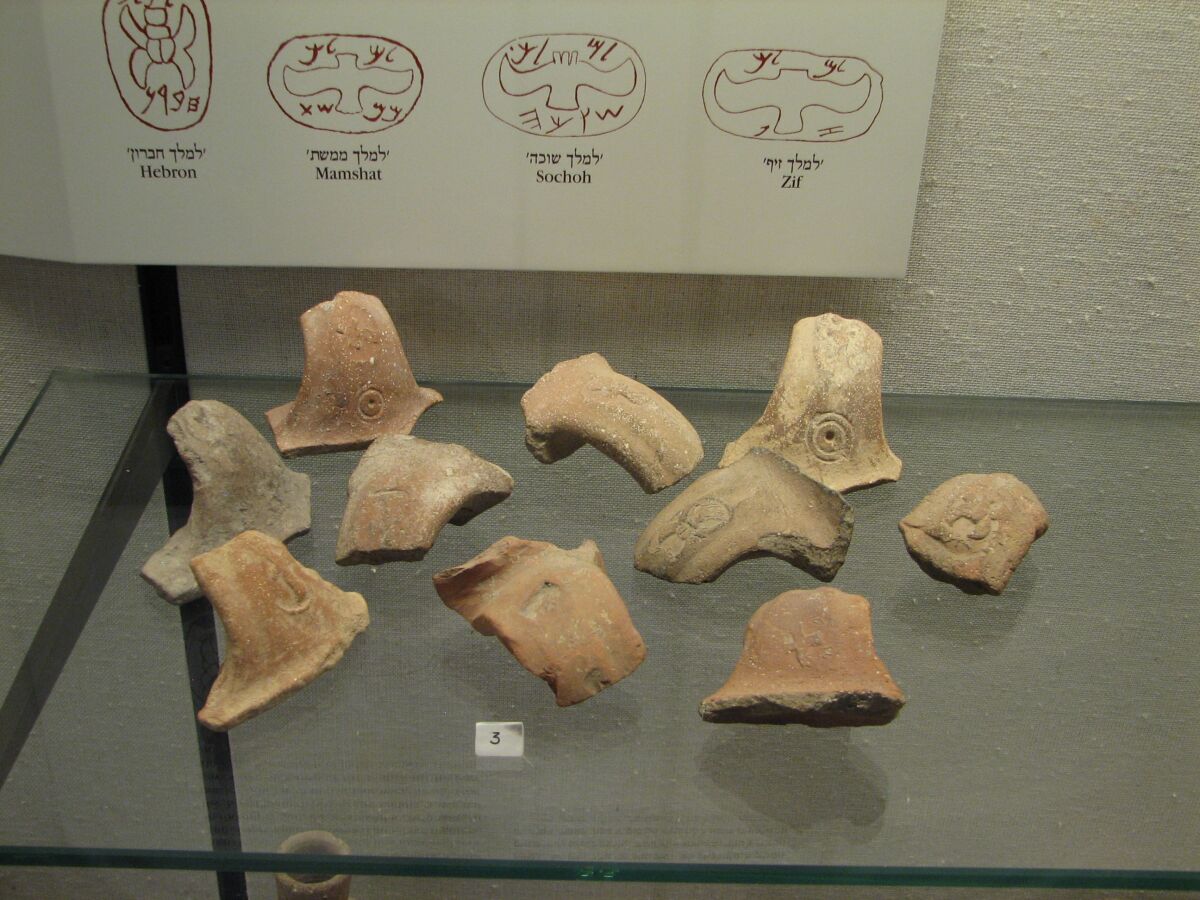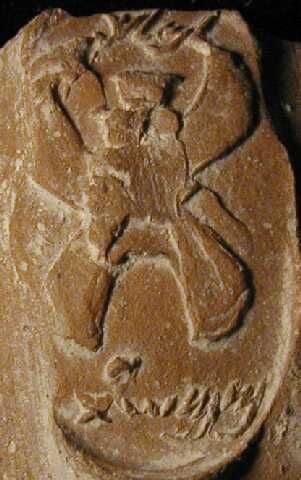In 1868, the first inscription bearing the paleo-Hebrew word mmst (ממשת) was documented. The inscription, stamped on a First Temple Period Judean vessel handle, was the first of many hundreds—probably now closer to 1,000—such mmst stamps that have since been discovered.
The stamps are of the famous lmlk (למלך), “to the King,” variety, dating to the reign of Judah’s King Hezekiah, during the late eighth century b.c.e. These vessel handle stamps typically bear the letters lmlk at the top, a central image of either a four-winged scarab or a two-winged sun, and a choice of one of four different words at the bottom: Hebron, Ziph, Socoh or our aforementioned mmst. Collectively, these various lmlk jar handle seal impressions number in the thousands and are generally seen as part of an administrative effort on the part of Hezekiah prior to the invasion of Assyrian King Sennacherib.
The first three seal types—those bearing the inscriptions “Hebron,” “Ziph” and “Socoh”—clearly refer to famous biblical cities. Yet there is no such Iron Age city, known either in the Bible or archaeology, by the name of Mmst, often vocalized as either “Mamshat” or “Memshet.” (There is a site of a similar name—ממשית—deep in the Negev; however, this is a much later Nabatean site founded in the first century b.c.e., and its Hebrew name is a later derivation of the Greek “Mampsis.”)

What could this word, then—found on numerous inscriptions throughout Judah—be referring to? For the past century and a half, the question has confounded researchers.
In a new paper published in the Jerusalem Journal of Archaeology in June, “The Enigmatic Mmšt in the Lmlk Stamps,” epigrapher Dr. Daniel Vainstub proposed an ingenious solution to the meaning of this term. He combined a reanalysis of the Semitic structure of the word, a reexamination of several of the seal stamps in question, and a reappraisal of 2 Chronicles 31 to propose that this word does not refer at all to an otherwise-unknown Judahite city but rather to a specific category of goods “from [the] mas’et”—Hezekiah’s collection of agricultural products in anticipation of the Assyrian invasion.
The ‘Impossible Root’

Vainstub began by highlighting the “impossible” Semitic root mms (ממש), if this is indeed a complete city name. He noted that, excepting Ethiopian languages, there are no known Semitic root words in which the first and second letters are the same (in our case, mm—ממ). No Canaanite, Hebrew, Arabic or other Semitic language branches bear such a pattern of repeat root letters in this manner—a “peculiarity in biblical Hebrew [that] was already observed by Rabbi Abraham ben Meir de Balmes (1440–1523)” and a “characteristic [that] is so deeply ingrained that it is still present today in the subconscious of native speakers of Hebrew and Arabic.” Thus, if a Judahite site existed bearing such a name, it would represent the only such confirmed word, let alone location, demonstrating such an unusual root structure.
Root aside, Dr. Vainstub also noted the reticence to develop personal or place names with the same first two letters prior to the Persian Period. Of the more than 800 toponyms in the Hebrew Bible, only five begin with the same first two letters, four of which refer to distant, foreign locations (Babylon, בבל; Dedan, דדן; Shushan, ששן; and Sheshak, ששך). And of the 1,700 personal names in the Bible, just 17 begin with the same first two letters; of these, 12 are foreign or late (i.e. Persian Period) figures; the remaining five are of obscure etymology.
Added to this, ancient Egyptian sources from the third millennium to the start of the first millennium b.c.e. refer to more than 300 place-names and tribes in Canaan—none begin with the same first and second letters. And of the more than 500 Iron Age personal names revealed by archaeology, only three bear the same first and second letters—all of which are foreign names.
Small wonder, then, that a city-site bearing such a name has not yet been found archaeologically or biblically. Something else must be intimated by this text.
The First Letter a Preposition—‘From’
In the Hebrew language, there are two equal forms of articulating “from”—either as a single word, min (מן), or in contracted form, as a prefix, m- (-מ). This would render our inscription: “from mst”—the latter part, mst (משת), now being the independent word in question.
But is “from” the correct interpretation of this initial letter? Remarkably, Dr. Vainstub highlighted a number of rare variant mmst seals that bear the inscription mn mst (מן משת)—containing an additional “n” between the “m”s. In his paper, he drew particular attention to four examples—one from Tell en-Nasbeh, two from Jerusalem, and one unprovenanced from a private collection.
In a personal conversation with Dr. Vainstub, he was almost beside himself in describing to me the first such seal discovered at Tell en-Nasbeh, which was initially published in 1947. “This was the proof!” he exclaimed. The seal had, at the time, been fully drawn and documented as mnmst—the additional “n” being a peculiarity that seems to have flown under the radar. This was the proof Vainstub needed: This longer, clear variant of the word “from,” min, proved that the shorter initial letter m- signified the same, the preposition “from” something.
But what was that something?
‘From’ What?
Dr. Vainstub argues that the remaining word mst (משת) represents a contraction of the Hebrew word mas’et (משאת).
Though the omission of the middle aleph (א, an unpronounced, glottal-stop consonant) may at first seem unusual, there is biblical and archaeological precedent for it. Vainstub provided a number of examples, such as the Siloam Inscription, which renders the word לקראת as לקרת (importantly, also an inscription from the time period of King Hezekiah).

Additionally, Dr. Vainstub highlights several examples of mmst impressions in which the letter aleph appears to be added to complete the word in full. As with the preposition “from,” this would bolster the interpretation that משאת is the correct word being rendered on these seal impressions, and that משת is merely a contraction of the term.
Considering all variants of this particular Hezekiah-period administrative seal, we therefore have ממשת/ממשאת/מן משת, all signifying the same thing: “from [the] mas’et.”
We are therefore left with the final, most important question of all: What was this mas’et?
Agricultural Preparations for War
“The term mas’et … is used in biblical Hebrew with several different meanings,” wrote Vainstub. “One of them expresses an ad hoc tax, contribution or offering, in contrast to the mandatory regular taxes and offerings to the kingdom and the temple. Thus, in Ezekiel 20:40, Zephaniah 3:18 and Psalm 141:2, it expresses a voluntary extra offering to the temple.” He continued:
[T]he Prophet Amos (5:11) denounces a merciless mas’et imposed on poor peasants, who were forced to deliver part of their crops to the government. Amos seems to refer to a mas’et imposed by King Jeroboam ii in the Northern Kingdom, in whose time the prophet was active. This mas’et closely resembles the one imposed by Hezekiah …. Jeroboam’s mas’et is called משאת-בר, mas’et of grain [a ‘grain tax’].
Armed with these parallels, Vainstub pointed to 2 Chronicles 31:4-20 as offering “an accurate account of the historical events related to the collection of the mas’et of Hezekiah.” This passage describes an enormous collection of various agricultural products. “From verse 12 onward, the text describes a comprehensive administrative organization established for distributing the food ‘in all Judah,’” wrote Vainstub. “It is tempting to connect this account with the ‘private impressions’ that occurred alongside the various lmlk stamps, manifesting a composite administrative network unparalleled in the history of Judah.”

“As these actions fit the implementation of the mas’et imposed by Hezekiah in view of the expected arrival of the Assyrian army,” Vainstub concluded, “in my opinion, the origin of the core story preserved in the book of Chronicles is, indeed, the collection of Hezekiah’s mas’et and its distribution in lmlk jars.” Thus, the Judahite storage jars stamped with this particular impression represented contents from this particular collection, administered by King Hezekiah during the first part of his reign.
It’s an intriguing solution to a 156-year-old puzzle. Indeed, the explanation is built on a number of relatively complex layers of explanation. It’s certainly not a simple case of, here’s an inscription with a biblical figure on it. But justifiably, there is a reason why this mmst mystery has proved difficult to crack for so long. It’s why, a century and a half after Sir Charles Warren excavated such mmst inscriptions from Jerusalem’s Ophel, we continue to unearth them in our own Ophel excavations (one of which I found personally, in 2013) and still wonder about what this word really means.
It seems the wondering is over.

